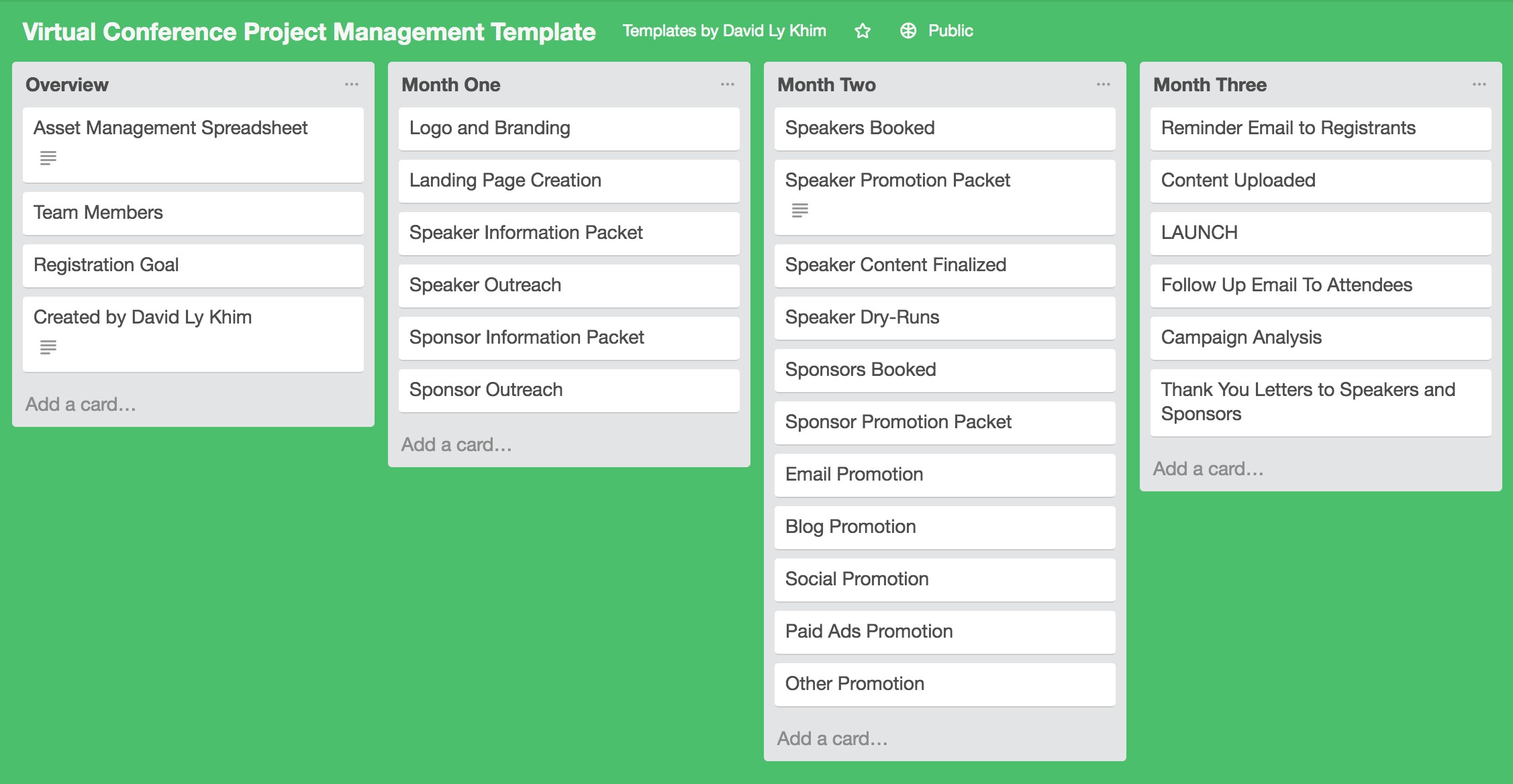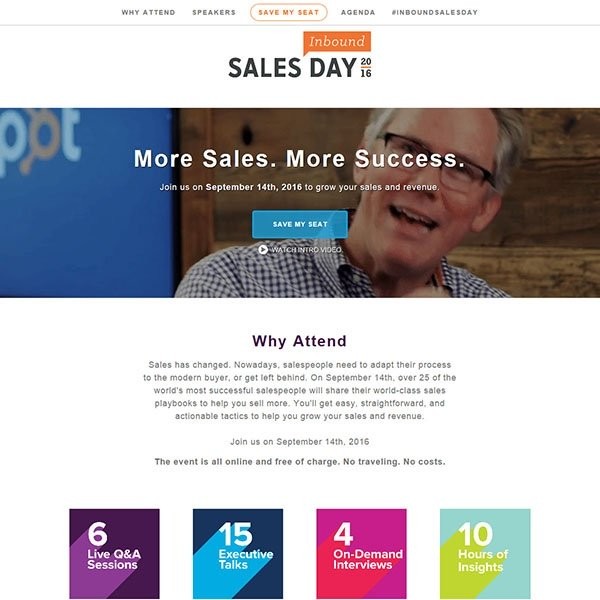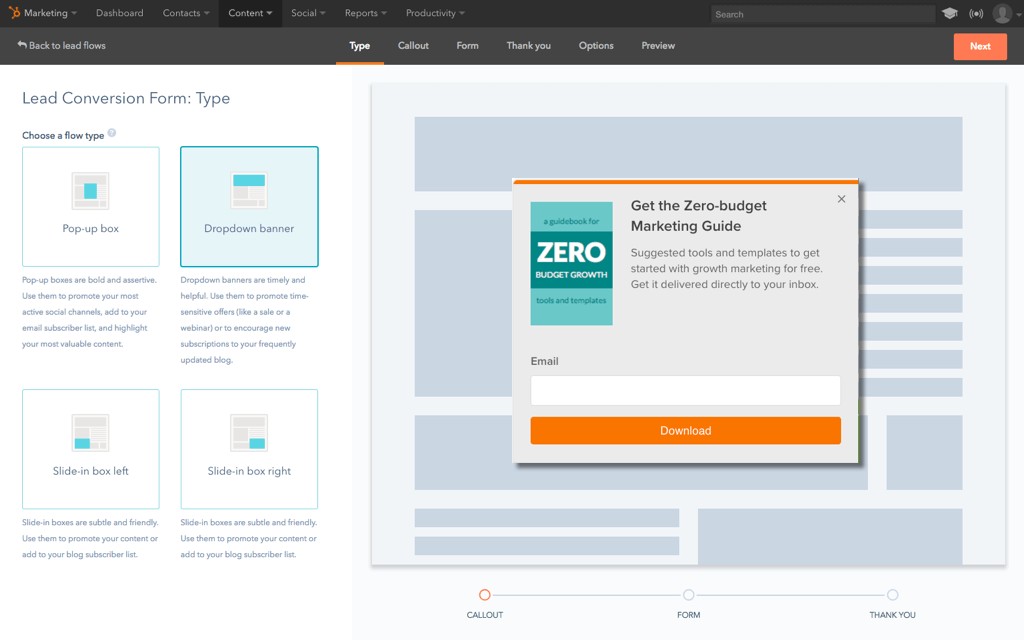When we say “virtual conference,” we don’t just mean webinars. We mean interactive, live panels, and microsites dedicated to the single purpose of promoting one event with various sessions a person can “attend.”
Virtual conferences have become a popular medium to develop and reach large audiences. From marketing to recruiting and sales to education, businesses in various industries have realized hosting online events are far cheaper than an in-person event — thus making it cheaper to build awareness around a brand.
We’re going to get into a lot, but by the end of this post, you’ll see the value in hosting a virtual conference and know how to organize and host your own event. You’ll have another medium to accelerate brand awareness, generate more leads, and develop authority as an industry leader.
In 2017, I helped launch Inbound Sales Day here at HubSpot, and I'm here to teach you how it's done. Continue reading to download my project management templates and emails I used to book speakers — all available for free.
Table of Contents
1) What is a virtual conference?
2) Why should you host a virtual conference?
3) A Virtual Conference by HubSpot
4) How to plan a virtual conference
Set the vision
Speaker outreach
Creation of assets
Promotion
Go live
Analysis
5) Virtual Conference Takeaways and Tips
What is a virtual conference?
Imagine a conference. There are dozens of rooms, booths with vendors trying to sell you their product, and a lot of people walking around. You might run into some very influential leaders in your industry, and you expect to see people on stage sometime during the event. You’re excited to hear them share lessons and tips they’ve learned from their own experience and journey to success.
Now, imagine a similar experience — but without having to leave your desk.
You log into an “event” online, where you can meet and interact with people through messaging platforms. You go into “rooms” (aka web pages) where you can watch speakers present their knowledge in the form of a recorded video.
It’s a simple concept: Get the content you would receive at a conference on your own time, when it’s convenient for you. It aligns perfectly with the culture and popularity of on-demand services, such as:
Lyft, with on-demand car rides
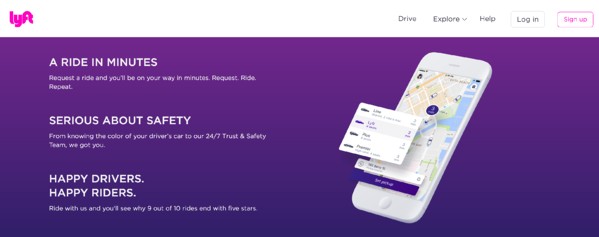
Drizly, with on-demand alcohol
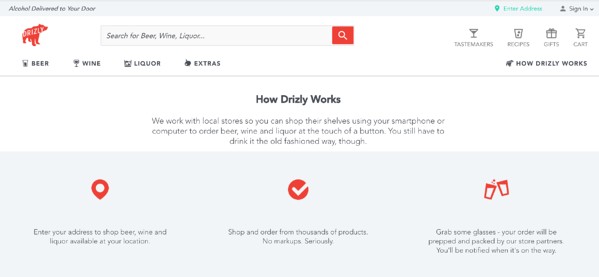
Soothe, with on-demand massages
Virtual conferences, with on-demand quality content and insights about the industry.
Virtual events began in 1993, presented by Alan Saperstein and Randy Selman. They started by videotaping trade show exhibitors booths and attaching the video to HTML floor maps. These events have become more popular among marketers for their lower cost and effort to produce.
Here’s an example of an HTML floor map:
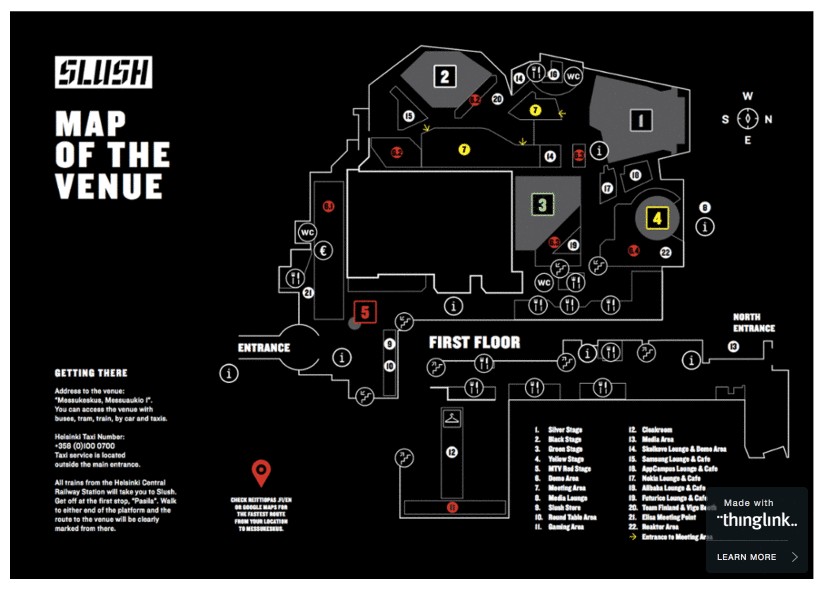
Examples of virtual events include:
- Inbound Sales Day, hosted by HubSpot
- Digital Agency Day, hosted by HubSpot and Unbounce
- Sales Acceleration Summit, hosted by InsideSales
- Digital Sales Engine, hosted by Sales For Life
You might be thinking, “There’s no way these events were produced by a small team.”
That’s fair. But I can tell you that I coordinated and launched Inbound Sales Day, a full-day virtual event with over 10 hours of video that garnered over 15,000 registrations globally. And I did most of it by myself in only three months. For a comparison, the team that organizes HubSpot’s live INBOUND event has over 10 people involved in planning the event for the entire preceding year.
It’s possible to host and launch one of these things, even with a small team, but why should you host a virtual conference in the first place? Why not just host a physical event instead?
There are numerous benefits to hosting online events. Let’s dive in.
Why should you host a virtual conference?
Consider some of the reasons you’d host a conference, either virtual or in-person:
- To grow awareness for your business. Depending on your market, there may already be competitors or other companies targeting the same target audience as you. You can use an an online conference as a means of partnering with those other companies.
- To generate leads.
- To acquire new customers.
- To create a revenue stream from sponsorships. People host these conferences strictly as a revenue stream. (Curious how? Sam Parr explains how he made a profit from hosting Hustle Con.)
- To build relationships with influencers.
Below are expenses to consider for a physical event (based on a 400-person hosted by Hustle Con):
- Venue ($5,000)
- Vendors, i.e., caterer, bartender, decorator, photographer, videographer, etc. ($10,000)
- Equipment rental ($2,000)
- Licenses and permits (dependent on venue)
- Transportation and parking for attendees and speakers (dependent on venue)
- Service fees and gratuities ($1,000)
- Speakers’ fees ($0 - $10,000+ per speaker)
- Signage ($500)
- Registration materials ($300)
- Security and staff ($2000)
Even for a smaller event, that totals at least $20,000. Soon, you're underwater and either hiring contractors or using half your team's day to get all the little details right. To top it off, there always seem to be attendees or speakers who are an absolute nightmare to deal with.
I’m getting stressed just thinking about it.
For an online conference, a few weeks of work and a small budget are all that’s needed. In fact, all of the software I used to organize everything was free:
- Trello for project management (check out my free template below)
- Google Sheets to manage the assets (you’ll get a template of this, too)
- YouTube to host videos
- Dropbox to host files
- Canva to create images
Plus, when you create assets for your event online, you continue reaping the benefits of long-tail keyword SEO and organic traffic from evergreen content for months to come.
Depending on your resources, you may want to hire freelancers to help you with asset creation or to run Facebook ads to get more awareness about your event.
In many cases, you end up cutting expenses dramatically by hosting an online event instead of an in-person conference. Let's dive into how we decided HubSpot should host an online conference about inbound sales.
A Virtual Conference by HubSpot
HubSpot revolutionized marketing in 2006 by introducing the concept of inbound marketing and telling the story of how marketing had changed. Since then, sales has also changed, and we’ve introduced the concept of inbound selling.
However, similar to when inbound marketing was a new concept in 2006, people needed to be educated about the concept of inbound selling.
We had various goals that overlapped with each other when thinking about hosting a virtual event:
- Spread the message of inbound selling
- Generate leads for our sales products
- Develop authority in the sales industry
- Promote the first sales-focused track at our INBOUND event
What better way to educate our audience and develop credibility around inbound selling than by hosting real experts to talk about it? Influencers already have an audience who will listen to them. They have their own methodologies and many of those ideas aligned perfectly with inbound selling.
By hosting a virtual conference, we were able to scale influencer marketing and associated the credibility of those influencers with the HubSpot brand.
Plus, with the changing landscape of content and more consumers preferring video content, this was an opportunity to develop high-quality video content we could continue to use.
Still interested in hosting your own online conference? I’m going to lay out all the steps I took to organize Inbound Sales Day that you can replicate for your own event. I’ll also give you the project management and email templates I created that kept me organized throughout the whole process.
How to Plan and Execute A Virtual Conference
Before we jump into the planning, decide how you’re going to manage the project. I used a combination of Trello and spreadsheets to manage my work.
I laid out all activities in my project management Trello board, which gave me a bird’s-eye view of the timeline, what needed to be done at the moment, and what was coming up. This allowed me to catch situations where I would need to delegate work or ask for help ahead of time.
All assets that were created (landing pages, emails sent, social posts, videos, etc.) were listed in an asset management spreadsheet. This way, I had access to every asset in one place without having to search for it.
The campaign was executed in six phases, which I’ll walk you through below:
- Set the vision
- Conduct speaker outreach
- Create assets
- Promote
- Launch
- Analyze
Phase 1: Set the vision
What do you want the event to look like? What topics do you want to cover? Who’s your audience? How many registrations do you expect?
All of this will be important for your speaker outreach as those will be your selling points. If you can pinpoint your target audience (try the MakeMyPersona tool to help with that), you can find speakers who also want to reach that audience. If you have a set number of expected registrations, you can attract speakers with an idea of what their reach will be if they participate.
[Go back to top]Phase 2: Conduct speaker outreach
The most important step to producing a viable virtual conference is to get speakers in your industry. This will benefit you in two ways:
- You can build relationships with these industry experts.
- You can associate your brand with these experts, making yours more credible.
I highly recommend getting experts within your company to speak on the subject matter and promote the event by giving a talk or interviewing another expert so that your employees will come to be seen as trusted industry thought leaders.
My goal was to get on a video call with the potential speakers I emailed. A video call allows you to sell them on the idea and show them how excited you are.
Here’s the email template I used:
Hi [NAME]!
[YOUR COMPANY] is launching [NAME OF VIRTUAL CONFERENCE], a virtual event for [#] [TYPE OF PEOPLE YOU’RE TARGETING] on [DATE] and we would love to have you as a featured speaker.
We’re inviting top experts in [INDUSTRY] to help [PROFESSIONALS] become more successful by providing actionable information about [BROAD OVERVIEW OF TOPICS].
I watched your talk on [TOPIC] and think you'd be a great fit for our audience.
If you're interested in speaking, we have many speaking options available that can be flexible with your schedule. I’d love to discuss them with you on a quick call.
Let me know if you're interested and we can schedule time this week or next to talk through the details.
For your convenience, here's a link to my calendar so we can schedule time right away: [MEETINGS LINK]
Best,
[YOUR NAME]
Pro tip: If you're a HubSpot customer, I recommend using the HubSpot Sales Meetings and Templates tools to make scheduling meetings really, really easy.
Once I got the meeting scheduled, I made sure to hit the following points for each conversation:
- Explain the event and why you’re doing it.
- Emphasize what the speaker would get out of participating. (We emphasized that we were aiming to reach over 10,000 salespeople and they would get their own landing page with links to their website and social profiles.)
- Tell them about other speakers you’ve booked to develop credibility around your event and that it’s something worth being a part of.
- If they’re interested, explain what we need from them right then and there: I asked for a rough title and outline of their talk, and the format they preferred (live Q&A, recorded interview, or recorded lecture-style video).
After the call, I immediately sent a follow-up email which:
- Recapped the call included topic and format of their talk
- Attached a speaker agreement form
- Asked for their availability to schedule introduction to interviewer, recordings, and dry-runs
- Listed specific deadlines of when everything is due
Here’s a template I used:
Hi [NAME]!
I'm glad we got to connect today. We're very excited that you're going to join us for [CONFERENCE NAME]. Here's a recap of what we discussed earlier -- feel free to revise any of it.
- Working session title: [SESSION TITLE]
- Working session description: [DESCRIPTION]
- Format: [FORMAT]
- What I need from you by [DATE]:
- Bio (max 200 words)
- Preferred headshot
- A page you want us to link to
- A rough outline of your presentation
Again, it was great connecting today! Please let me know if you have any questions.
Hope you have a great week!
Best,
[YOUR NAME]
A week later, I followed up again for all those items. Speakers are really busy, and it’ll take a few emails and calls to get those details from them. This is why I suggest you begin the process at least two months before your launch date.
Some speakers will ask for a packet with more details. You can use this template to create your own speaker packets.
Phase 3: Create assets
On my Trello board, I laid out a timeline of when all assets were created and used a spreadsheet to keep track of them as they were created.
Landing Pages
Your landing page is going to be a selling point for your event to get speakers and attendees. Don’t expect to attract many of either if your page doesn’t look sharp.
Below you can see the homepage, agenda page, and session pages we created for Inbound Sales Day.
The homepage highlighted the benefits of attending and the various speakers we featured.
The agenda page shared more details about what topics will be discussed and the main takeaways of each talk. This gave viewers an opportunity to see who would be speaking and do their research or reach out to influencers before the event.
The session page is where the fun happened. Each video had its own landing page on the HubSpot domain so viewers wouldn’t have to leave our website to see the content. We had over two-dozen of these pages.
| Landing Page | Agenda | Session Page |
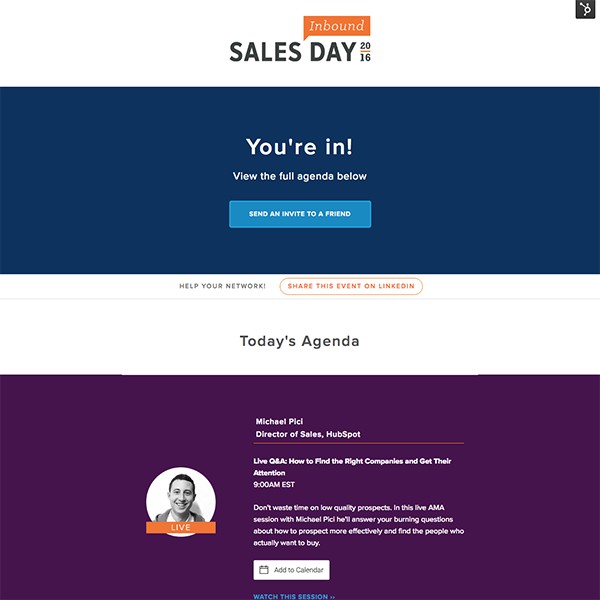 |
 |
Click the images to see the full versions
Video Hosting
I recommend using YouTube Live to broadcast live videos and to host all videos to take advantage of its video SEO. I then embedded all the videos on landing pages so people wouldn’t have to leave our website to watch the video.
Video Production
There were three different session formats which each required different preparatory measures. Here was my process for each format:
Live Q&A
- Speaker chose topic
- Researched their online material (blogs, videos, interviews) and created a Google Doc of canned questions
- Introduced the speaker to the employee who would host the session via email and set up a call to develop their rapport
- They reviewed the list of questions together and brainstorm more questions
- We prioritized top five canned questions to ask in case there were no live questions
- A week before the live session, get on a call with the speaker to do a final check-in (the meeting was hosted using a private YouTube Live session so they understood how to sign in)
- Live broadcast: Speaker was expected to sign into YouTube Live an hour ahead of time for audio and video check, review the talk points with HubSpot host, and build rapport for the session
Recorded Interview
- Speaker chose topic
- Researched their online material (blogs, videos, interviews) and created a Google Doc of canned questions
- Introduced the speaker to the employee who would host the session via email and set up a call to develop their rapport
- They would review the talk track outline and go back and forth about what topics the speaker would want to hit on
- We agreed on five questions that would be asked by the interviewer to guide the conversation
- Booked an hour with the speaker and interviewer which gave enough time for audio and video check, review talking points, and record at least twice (in case the first run was too rough
Recorded Lecture
- Speaker chose topic and provided outline of talk track
- Provided feedback on their outline based on what our sales audience is interested in (based on previous campaigns and blog performance)
- Two recording options:
- Book an hour of their time to record the session via YouTube Live
- They recorded on their own and sent the video
Question Submission Form
For live events, we created a Google Form for people to submit questions ahead of time. These questions were used to inform talking points for relevant sessions.
Social Media Images
The obvious goal for social media images is to make a person stop scrolling through their newsfeed and read what the event was about. We went with blinking GIFs that included photos of the speakers.
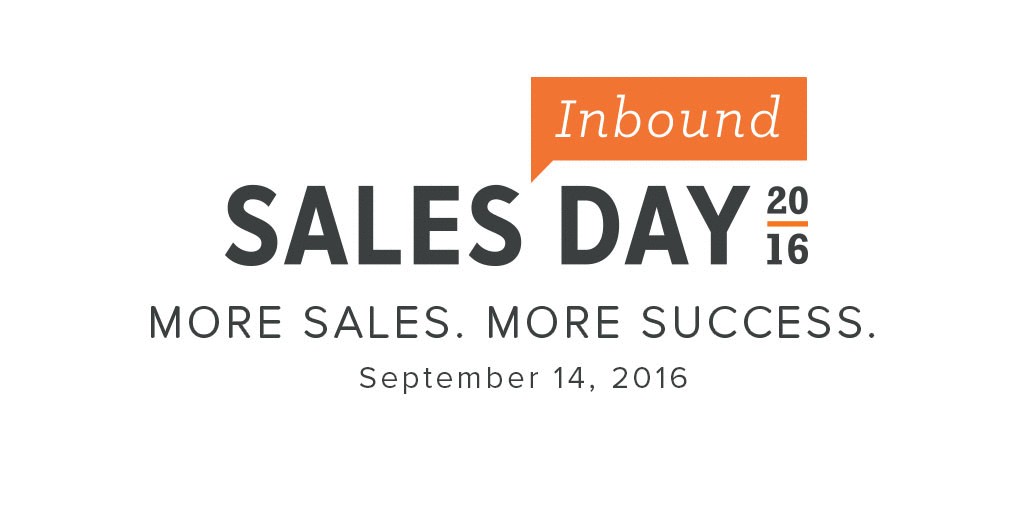
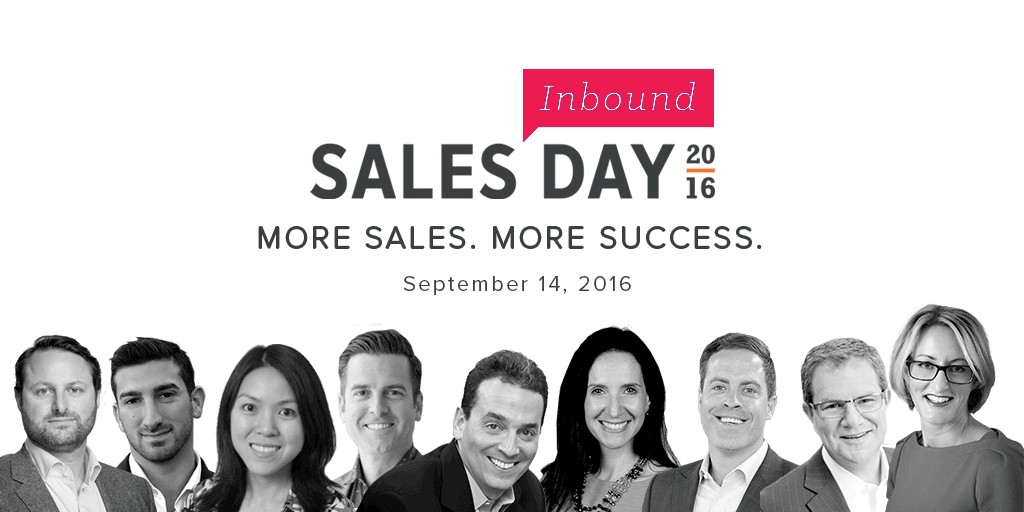
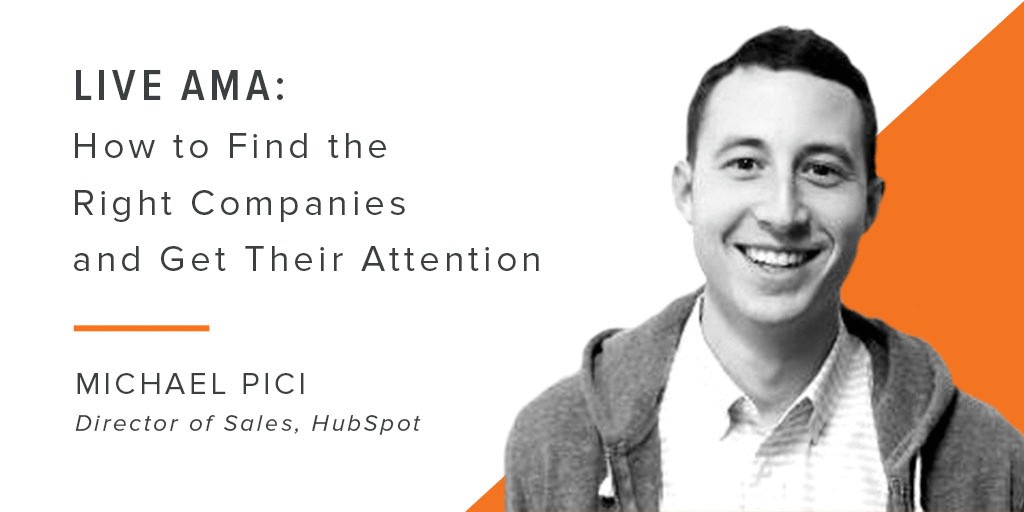
Phase 4: Promote
As with content distribution in general, this was the most difficult part of the process. We leaned into speakers a lot and asked them to promote the event to their email list and on their blogs and social profiles.
Speakers: Email, Blog & Social
We asked each speaker to send an email to their list, write a blog post, and post on social media about the upcoming event. We made it as easy as possible for speakers to promote the event by creating speaker promotion packets, which provided pre-written emails, blog posts, social media copy, and images. All they had to do was copy and paste the text and insert the image.
We also gave each speaker their own unique tracking URL (learn how to do it using HubSpot software) to use in promotional materials. This showed us how much interest each speaker drove and how many registrations they contributed.
Don’t start a packet from scratch, get the free speaker promotion packet template.
Blog Posts
Brainstorm blog post topics based on the topics your speakers will discuss, and come up with a publishing cadence for your promotional posts. If you already have an editorial calendar, I’d suggest you avoid making every post promotion and instead periodically insert promotional posts.
Social Posts
I met with HubSpot's Social Media team two months before the event launch to discuss the campaign and come up with a promotional cadence that made sense for each channel.
I used a spreadsheet to organize all social media posts. I wrote most of the copy in bulk and scheduled the posts in batches as each date came up.
Your promotion strategy will vary depending on which channels you have access to. I sat with my team and brainstormed promotional tactics before deciding which were most viable. A few of those included:
- Pop-up forms on highly trafficked site pages
- Calls-to-action on the home page
- Posts in relevant LinkedIn and Slack groups
- Links to the event in sales reps' email signatures
Phase 5: Launch
The night before your launch, make sure:
- All recorded videos were hosted on YouTube
- Landing pages that hosted videos were tested
- Reminder email to registrants have been scheduled so they remember to watch the videos
- Emails are pre-scheduled to notify speakers to log into YouTube Live an hour before the broadcast time
On the day of the event:
- Monitor your social media hashtag if you have one
- Keep an eye on your email if case people have trouble accessing the event
Phase 6: Analyze
To prove that the virtual conference was worth the time and effort, do an analysis of the traffic and registrations you received, how many video views you got, and send a survey to your registrants.
The best way to prove value is to tie it all back to revenue. How many qualified leads did you get, and what is the monetary value of a lead? How many new software signups did you get and what is the worth of each signup? How many new clients did you get and how much are they paying you?
Learning Lessons and Tips for Hosting A Virtual Conference
As always, no matter how successful the event, things can always be better. Here are a few things I wish I had done differently that you can learn from.
Align with your sales team.
This event would’ve been great for sales enablement. Sales reps could use the conference as a piece of content to share with prospects and be helpful. It’s also good to let reps know about the event and how to talk about it in case prospects bring it up on a call.
Get speakers with large audiences.
This may be more difficult for your first event as you start developing credibility for your event, but get speakers with large audiences if you can. It’s even better if you can get them to commit to driving a certain number of registrations.
Have a post-event plan.
Ideally, you’re going to get a lot of registrations for the event. What are you going to do with them after the event? Have a communication plan for your registrants, whether it’s sending them content, telling them about your products or services, or asking for feedback. Don’t leave them hanging.
Build anticipation before the event.
How can you get registrants to share the event before it happens? Maybe a contest or giveaway? How can you get registrants to engage with speakers before the event?
As more companies work to get a foothold in their industries and the marketing industry evolves to encompass more video content, virtual conferences will become more and more common. And as with any marketing tactic, as virtual conferences become more common the medium will become less effective.
Host your first virtual conference now before your competitors and gain first-mover advantage. Good luck.
Here are all the resources and templates I’ve shared throughout this post:
- Project management template for Trello
- Speaker information packet template
- Speaker promotion packet template
Thanks to Kendrick Wang, Cambria Davies, and Scott Tousley for reviewing drafts of this post.
Editor's note: This post was originally published in April 2017 and has been updated for comprehensiveness.

